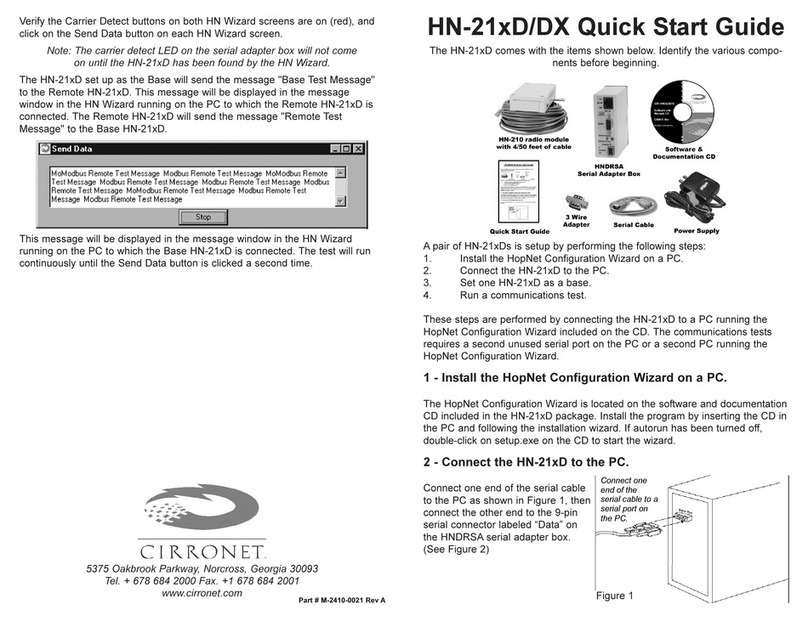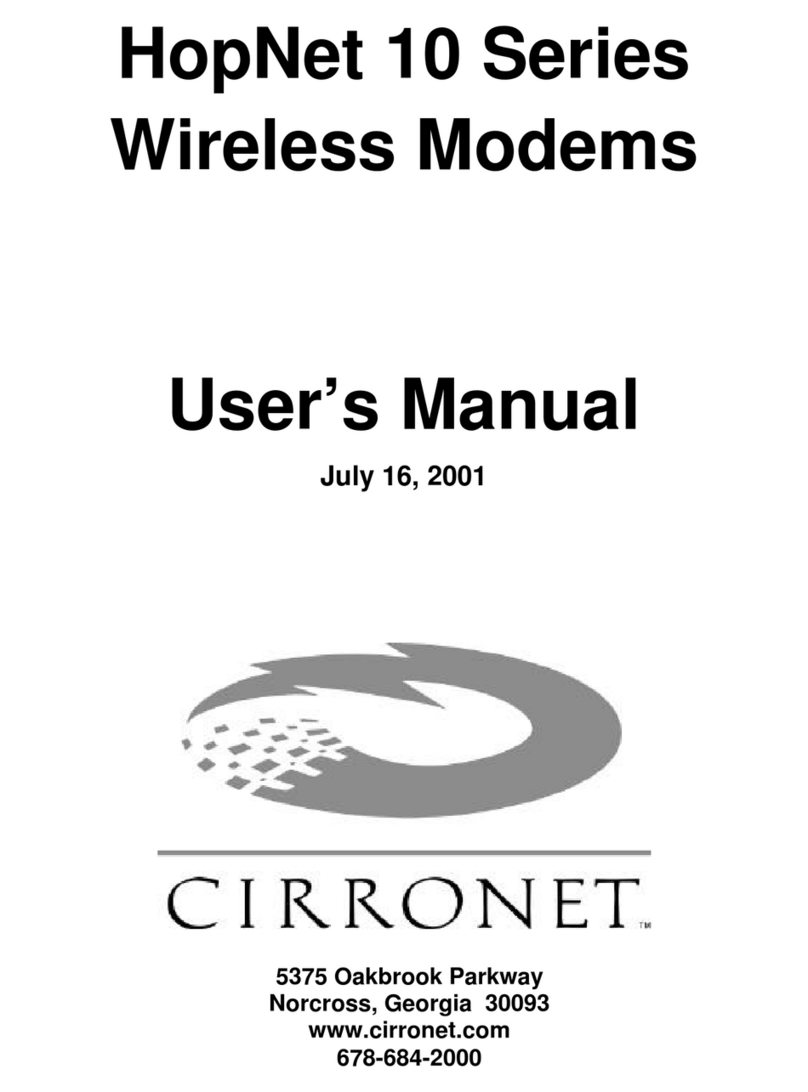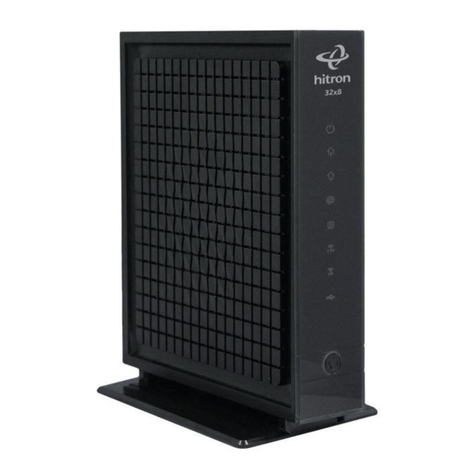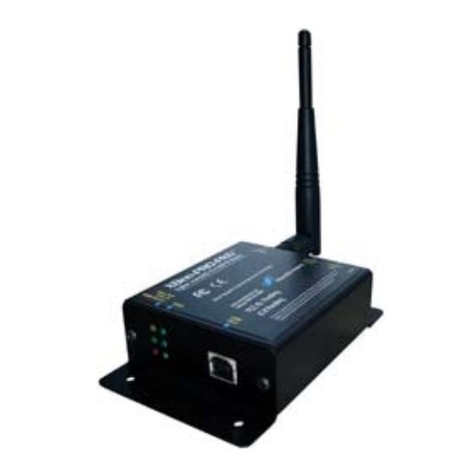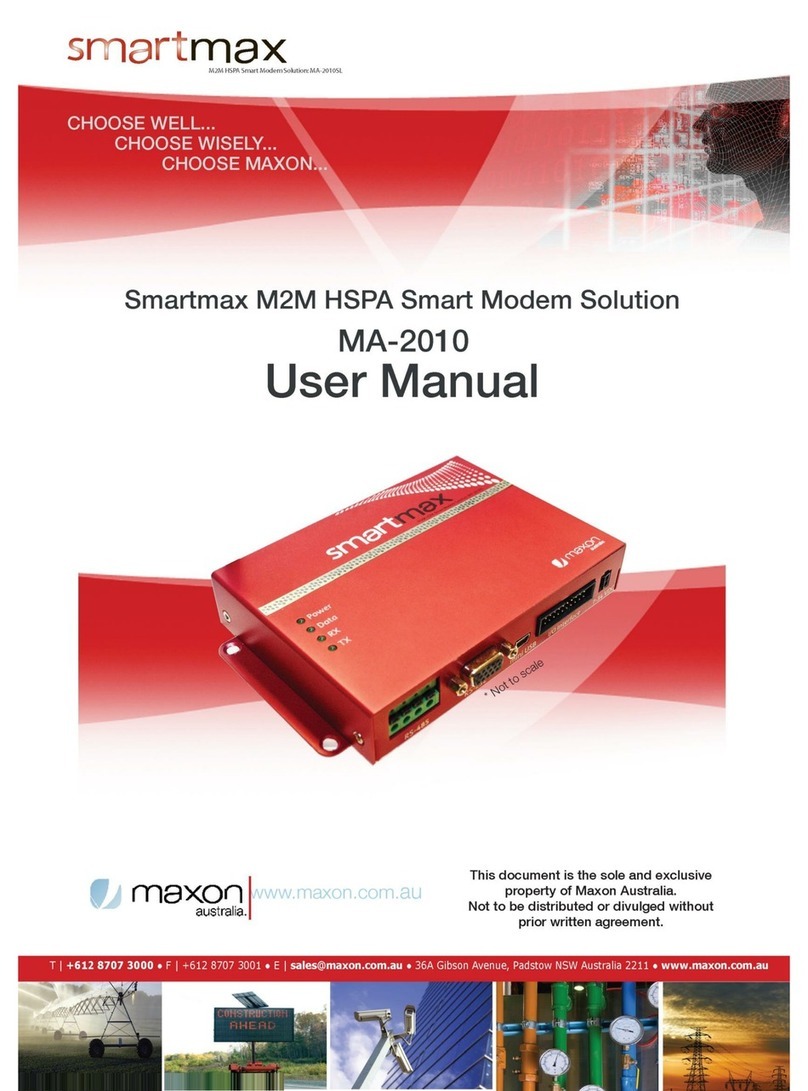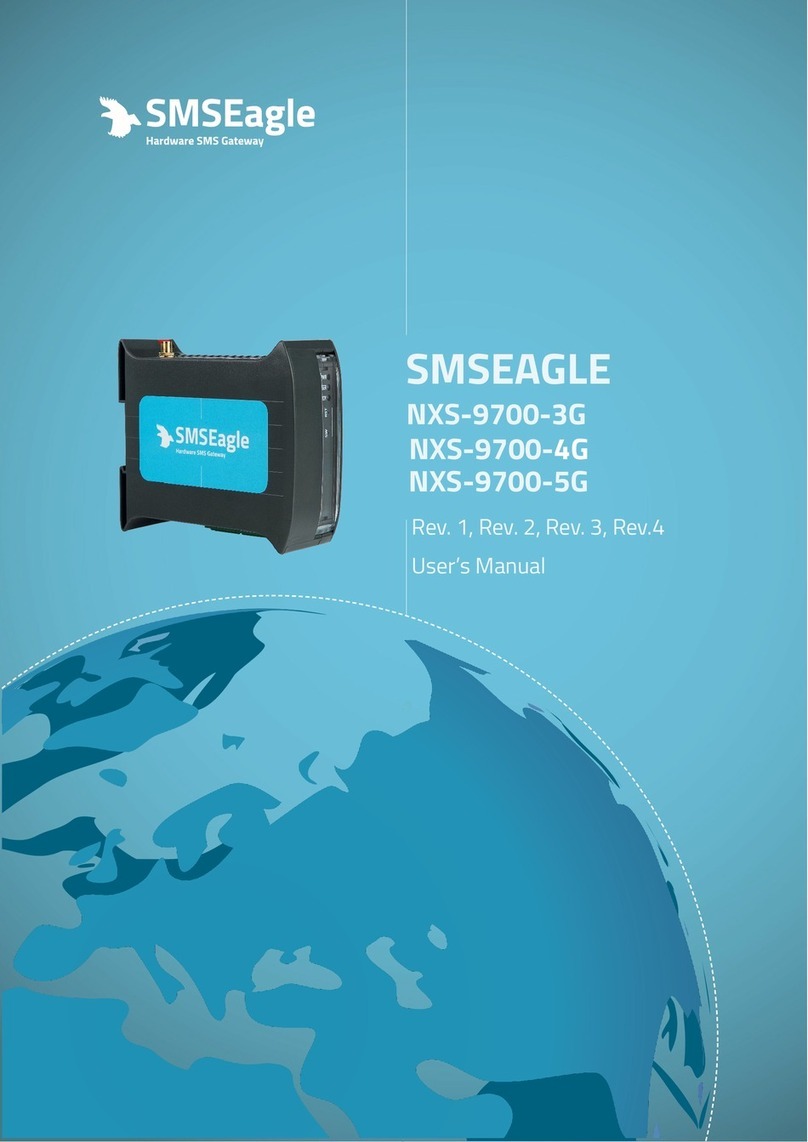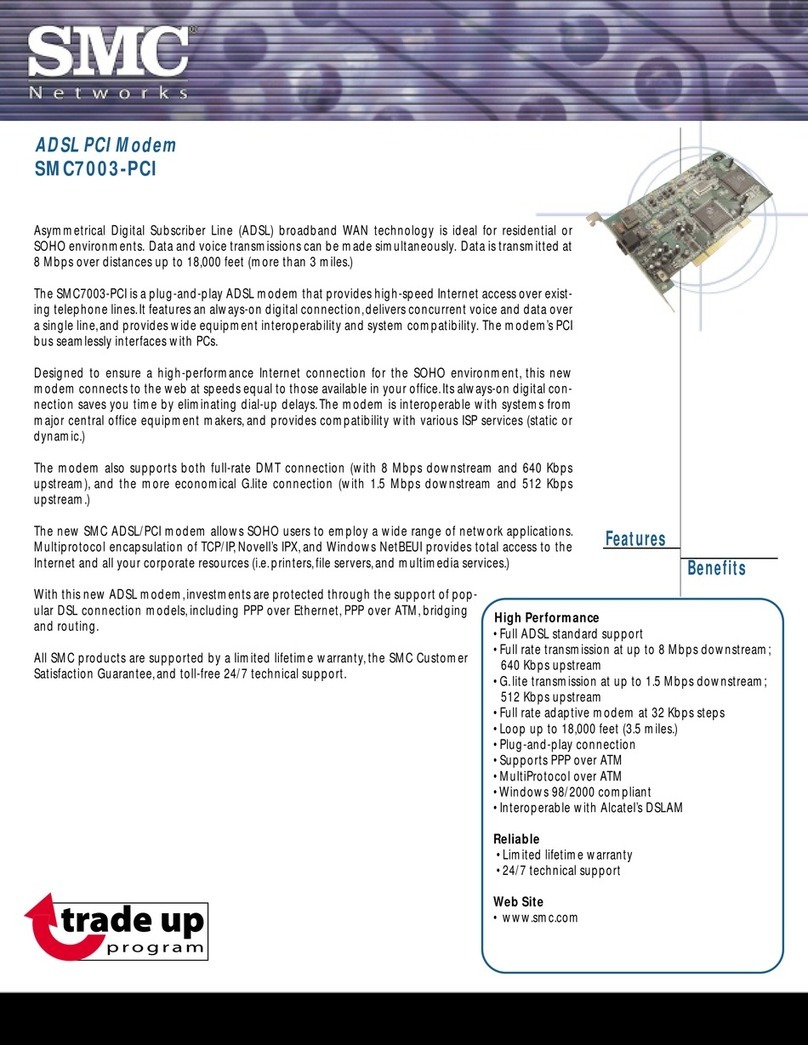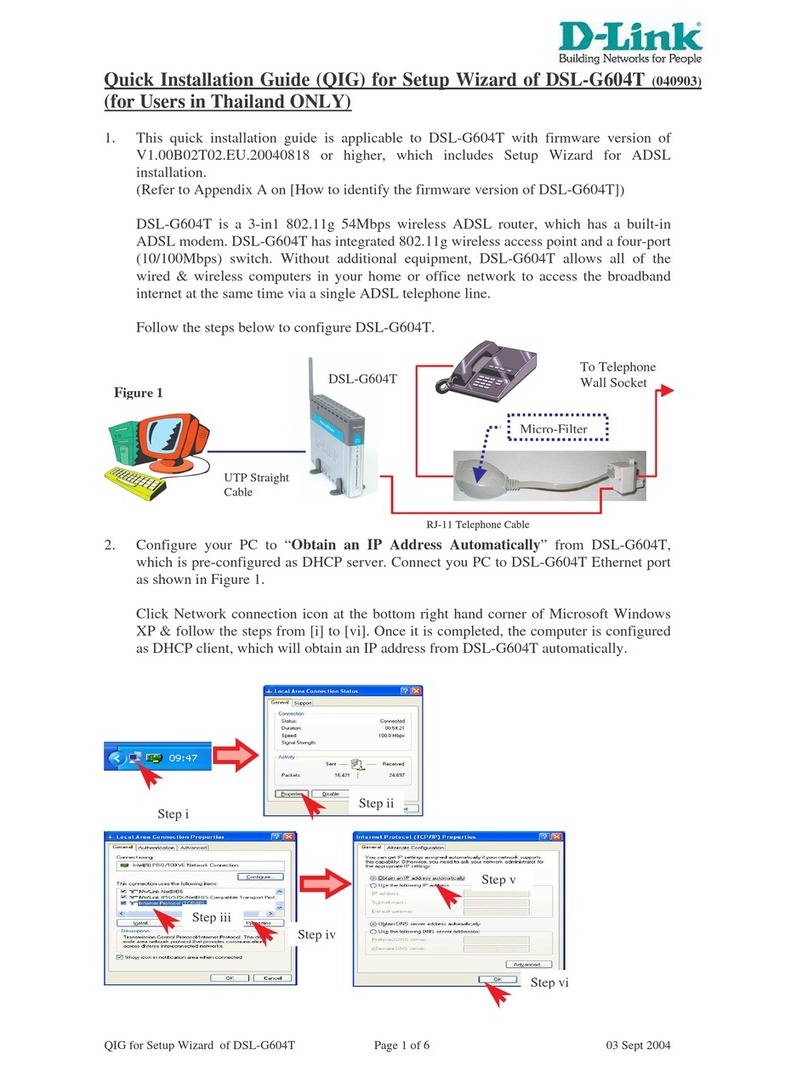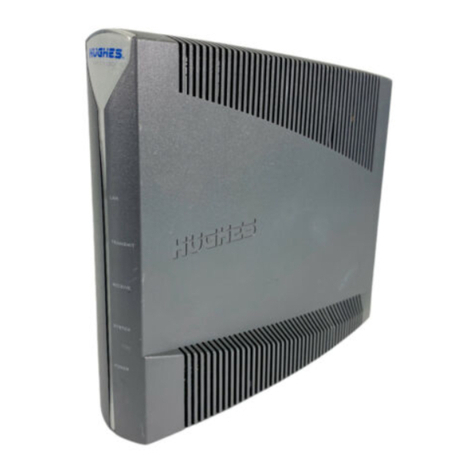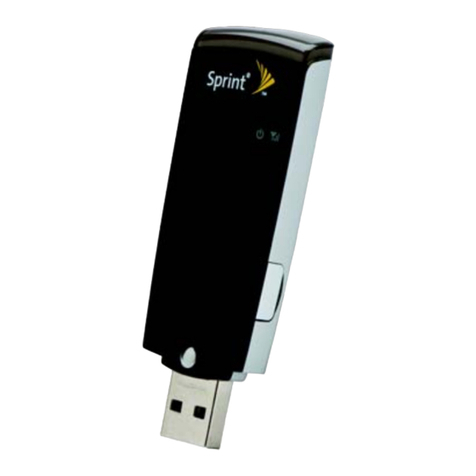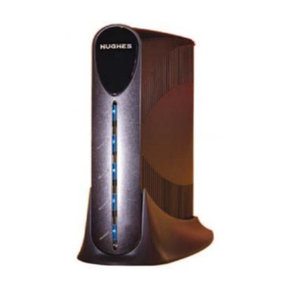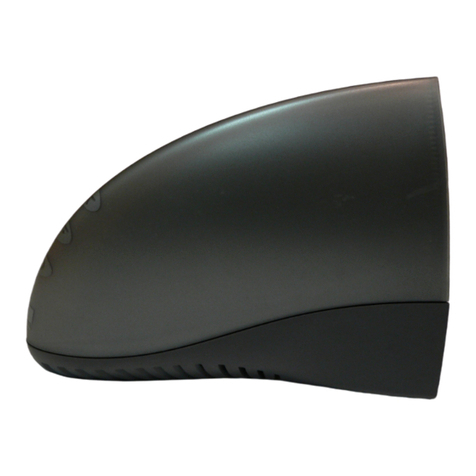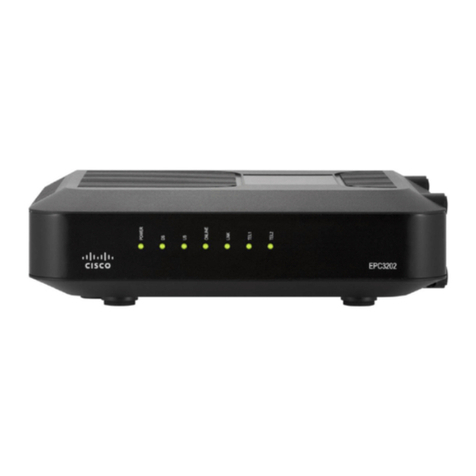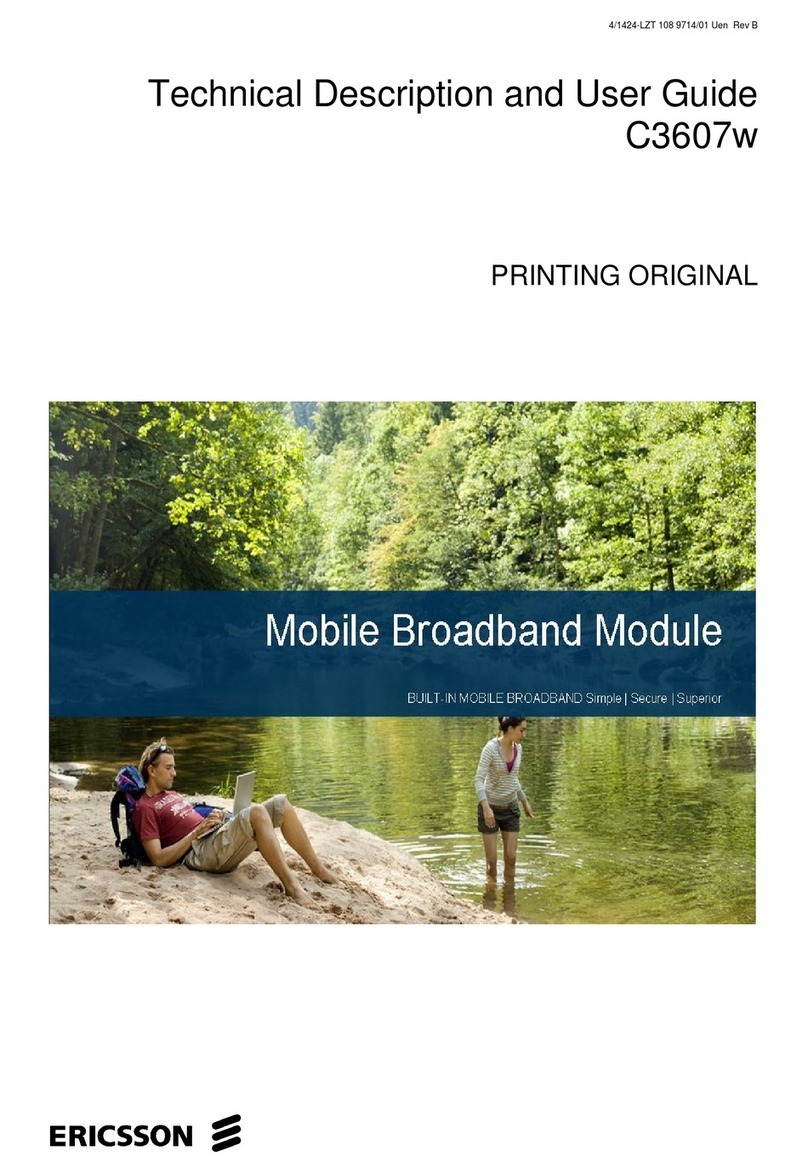Cirronet SEM2410 User manual

SEM2410
Wireless Ethernet
Modem/Bridge
User’s Manual
October 17, 2001
5375 Oakbrook Parkway
Norcross, Georgia 30093
www.cirronet.com
(678) 684 -2000

Transmitter Module FCCID: HSW-2410M.
Note: This unit has been tested and
found to comply
with the limits for a class A digital device, pursuant to
part 15 of the FCC Rules. These limits are designed to
provide reasonable protection against harmful
interference when the equipment is operated in a
commercial environment. This e
quipment generates,
uses, and can radiate radio frequency energy and, if not
installed and used in accordance with the instruction
manual, may cause harmful interference to radio
communications. Operation of this equipment in a
residential area is likely
to cause harmful interference
in which case the user will be required to correct the
interference at his own expense. Commensurate with
EIRP limits specified in FCC Rules 15.247b, this
device may not be used with antennas that exceed
36dB of gain in point-to-
point applications or 16dB of
gain in multi-point applications.

Table of Contents
Introduction .......................................................................................................... 1
Getting Started..................................................................................................... 2
Connecting the SEM ......................................................................................... 2
SEM Status Indicators....................................................................................... 3
Configuring the SEM......................................................................................... 3
SEM Operation..................................................................................................... 6
Overview........................................................................................................... 6
Point-to-Point Mode........................................................................................... 6
Point-to-Mulitpoint Mode ................................................................................... 6
TCP/IP Addresses................................................................................................ 8
Filtering ............................................................................................................. 8
DHCP................................................................................................................ 8
SEM Command Set............................................................................................ 10
Ethernet Commands ....................................................................................... 10
SEM/Radio Commands................................................................................... 11
SEM System Commands................................................................................ 13
Radio Modem Configuration............................................................................... 14
Radio Commands............................................................................................ 14
Distance Optimization ..................................................................................... 15
Specifications..................................................................................................... 17
Radio Specifications........................................................................................ 17
Connectors...................................................................................................... 17
Indicators......................................................................................................... 17
Power.............................................................................................................. 17
Troubleshooting ................................................................................................. 18
Technical Support ........................................................................................... 18
Warranty............................................................................................................. 19

2000, 2001 CirronetIncorporated 1M-2410-0007 Rev -
Introduction
The SEM2410 family of products from CirronetIncorporated provides wireless
Ethernet connectivity between networks located more than 5 miles apart. Built around the
WIT2410 frequency hopping spread spectrum data modem, SEM products provide a
10BaseT connection to Ethernet networks. SEM products operate in a point-to-point
mode or a point-to-multipoint mode using a star configuration. The center of the “star” is
the Master device and the remote SEMs are Slave devices. Peer-to-peer communication
is accomplished by using the master SEM device to relay datagrams from one slave SEM
device to another slave SEM device.
Contained in ruggedized enclosures, SEM products are designed for factory and
industrial applications. The communication between SEM products is performed using
the WIT2410 over-the-air protocol. Thus the SEM products are 802.3 compatible but not
802.11 compatible and provide 460Kbps data throughput. Certified by the FCC and
ETSI, and CE marked, SEM products can be deployed license-free around the world.
The SEMs enjoy the same benefits of frequency-hopping spread spectrum technology
that the WIT2410s do. Namely, the immunity to multipath fading and resistance to
jamming that is provided by changing frequency every few milliseconds. Operating in the
2.4GHz ISM band, SEMs can be used license-free worldwide and are not subject to the
congestion in the 900MHz band caused by cordless telephones.
The radios in SEM products include a robust over-the-air protocol. This protocol insures
error-free data through the use of a 24-bit CRC and ARQ to detect errors and to
automatically request a retransmission. All of this is transparent to the network which just
sees complete error-free data.

2000, 2001 CirronetIncorporated 2M-2410-0007 Rev -
Getting Started
The SEM family of wireless Ethernet modems are easy to install and operate. In most
instances, the only installation steps will be setting IP addresses, selecting one modem as
the master and connecting the antenna, power and Ethernet cable.
Connecting the SEM
Figure 1 identifies the various connectors on the rear of the SEM.
Figure 1. SEM Rear Panel Diagram
The antenna connector is a TNC type connector. An antenna may be connected directly
to this connector. Alternatively, an antenna may be located away from the SEM using RF
cable to connect the SEM to the antenna. Cirronet does not recommend using RF cables
longer than 5 feet. If more distance is required between the SEM and the antenna, high-
quality, low-loss RF feed line must be used. Alternatively, the SEM2410X has a remote
radio assembly that is mounted next to the antenna. The remote radio assembly is
connected to the SEM through a baseband cable that can be ordered in 100 foot
increments up to 500 feet in length. The SEM2410X has a 15 pin connector in place of
the TNC connector on the SEM2410.
The 10BaseT Ethernet connector is the standard RJ-45 connector. The connector is wired
to be able to connect directly to an Ethernet device using a straight-through cable without
having to connect through a hub. If it is desired to connect the SEM to a hub, the SEM
must be connected to the Uplink port of the hub to use a straight-through cable.
Otherwise a cross-over cable is needed to connect a SEM to a hub. The Ethernet
connector has two LEDs built in. The green LED on the left indicates a good Ethernet
connection. The yellow LED on the right indicates network collisions. When the yellow
LED is on continuously, it indicates that there is sufficient network congestion to impact
data throughput.
The synchronizing signals are provided for special applications where multiple master
SEMs are co-located. The synchronizing signals are RS-485 levels and may be connected
Power Connector
Synchronizing Signals
10BaseT Ethernet Connector
TNC Antenna Connector
Ethernet Link
Ethernet Collision

2000, 2001 CirronetIncorporated 3M-2410-0007 Rev -
using an RJ-11 connector. If the sync signals are required, one of the master SEMs must
be designated as the sync master. See the section SEM/Radio Commands for details. If
there are no co-located master SEMs, sync should be left disabled.
The power connector is a 2-pin DIN type connector. The provided AC adapter provides a
9 volt power level to the SEM. The SEM can accept DC voltages ranging between 7VDC
and 26VDC if alternative power supplies are to be used.
Figure 2. SEM Front Panel Diagram
The Configuration Port is an RS-232 serial port that may be used to configure the SEM.
This is useful when the default IP address of the SEM cannot be used with the existing
network preventing configuration through a telnet session. See the section Configuring
the SEM for details of using this port.
SEM Status Indicators
The PWR indicator on the front panel indicates that power is applied to the SEM and that
the power switch is in the ON position.
TXD and RXD are indicators of data activity. They indicate the transmission and
reception of data over the Ethernet connection. Note that these LEDs can be active even
when the SEM is not communicating with another SEM.
On a slave SEM, the Link A LED indicates the SEM has established a connection with
the master SEM. When a slave SEM is powered on, it will take a few seconds for this
LED to turn on. On a master SEM the Link A LED is always on. The Link B LED is not
used.
Configuring the SEM
SEMs are shipped from the factory with default settings that include a default IP address
of 0.0.0.0 and a default configuration as a slave bridge. In order to set up a wireless link,
alternate IP addresses need to be assigned and one of the SEMs must be configured as a
master device. If a BOOTP or DHCP server is not present a different IP address must be
assigned to the SEM. If a DHCP server is present on the network, the IP address can be
set up through it. See the sections BOOTP and DHCP for details.
SEM 2410
2.4 GHz SPREAD SPECTRUM WIRELESS ETHERNET MODEM
Power Switch Status Indicators Configuration Port

2000, 2001 CirronetIncorporated 4M-2410-0007 Rev -
The network that the SEM is connecting to must be compatible with 10BaseT products.
The SEM will not work if the network only supports 100BaseT or half duplex 10BaseT
products. Before connecting a default configured SEM to an active network that does not
have a BOOTP or DHCP server, ask the network system for an IP address for the SEM
that will not cause any problems on the network.
The SEM can be configured two ways. The first is through the serial port. The settings
for the serial port are 38400 baud, 8 data bits, 1 stop bit, and no parity. SEMcom will
automatically find the appropriate serial port and configure the serial port settings for
you. The software will inform you of its progress and any problems that arise. After a
few seconds the SEM firmware version is displayed followed by the SEM> prompt.
To set the IP number of the SEM, use the ip command.
ip <xxx.xxx.xxx.xxx> {yyy.yyy.yyy.yyy}
Where x is the new IP address, and y is the optional netmask number.
Once a valid IP address has been entered in the SEM, a second method to configure the
SEM is through a telnet session. Most telnet programs work with the SEM. Windows
95/98/NT/2000/ME have a telnet program that works with the SEM. A telnet session can
be started by clicking on Start->Run if you have Windows 95/98/NT/2000 and the
TCP/IP client has been installed. For a SEM with an IP address of 192.168.0.254, enter
the following information in the dialog box:
telnet 192.168.0.254
A telnet window will open up. The first line is the version of the SEM firmware followed
by the prompt:
SEM>
If the SEM is to transmit data to devices not on its subnet, a default router must be
specified. To enter the default routing address use the route command.
route add default <xxx.xxx.xxx.xxx> {yyy.yyy.yyy.yyy}
Where x is the IP address of the gateway device and y is the optional netmask number.
To configure a SEM as a master device, use the bridge command:
bridge master<CR>
The SEM2410 includes provision for filtering of multicast and broadcast packets. In
many networks, there is sufficient multicast and/or broadcast packets to slow the overall
performance of the SEM. By turning filtering on, the SEM will ignore these packets and
limit transmission to packets with specific device addresses. In some instances, it will be
desired to have the SEM transmit the multicast and broadcast packets; in this instance
filtering should be disabled. Note that filtering broadcast packets also filters multicast
packets but filtering multicast packets does not filter broadcast packets. To filter
broadcast and multicast packets use the bridge filter command:
bridge filter bcast<CR>
Refer to the section SEM/Radio Commands for details of the filter commands.

2000, 2001 CirronetIncorporated 5M-2410-0007 Rev -
Store the changed configuration parameters in non-volatile memory with the save
command:
save<CR>
The SEM will report back the time it took to the save the information. Reset the SEM by
typing:
reset<CR>
The SEM can also be reset by cycling power. Whenever a reset is executed on the SEM,
the telnet session will be lost. It will take the SEM about 30 seconds to reinitialize after a
reset or after cycling power.
Note: Failure to save and reset will result in the factory defaults being used.

2000, 2001 CirronetIncorporated 6M-2410-0007 Rev -
SEM Operation
Overview
SEM devices are wireless Ethernet modems that perform bridging functions in point-to-
point or point-to-multipoint configurations. SEM products are designed to connect
remote network segments together while keeping the data traffic between the network
segments to a minimum. SEM products use MAC-layer addresses to learn on which
network segment a device is located.
A master SEM can connect up to 5 remote slave SEMs. The SEM2410 is a single channel
device with an over-the-air data rate of 460Kbps providing 230Kbps data throughput.
The radio modems in the SEMs are factory configured with optimum settings for typical
point-to-point applications. The radio parameters can be configured to optimize data
throughput, latency and range for whatever the application. In addition, the radios in the
SEMs can be configured to allow multiple SEM networks to be co-located.
Point-to-Point Mode
In point-to-point operation, one SEM is configured as the Master and the other is
configured as a Slave. While this is necessary for operation, it does not matter which
SEM is the master and which is the slave. The radio in the master operates as the base
radio. Configuring the SEM as the master automatically configures the radio in the
master as a base radio. Similarly, configuring a SEM as a slave automatically configures
the slave radio as a remote radio.
When a master SEM is powered on, it becomes active immediately, even if no slave
SEMs are detected. It will attempt to send packets addressed to devices that it thinks are
not on its local network. When a slave SEM is powered on, it listens for a master SEM
and attempts to register with the radio in the master. This detection and registration
process can take up to 2 seconds. During this time, no packets will be sent or received
over the RF link by the slave.
If the application is such that more than one point-to-point link needs to located in the
same area, each master/slave pair must be assigned different network numbers. This will
allow the SEMs to identify the appropriate other SEM to which they should
communicate. Because different network numbers have different hopping sequences, this
also allows various pairs to operate in the same area without interfering with each other.
Refer to the section on radio commands for details on setting network numbers.
Point-to-Mulitpoint Mode
In point-to-multipoint mode multiple slave SEMs link with a single master SEM. Similar
to the point-to-point mode, each slave must register with the master, a process that can
take up to 2 seconds. All of the radio addressing and registration occurs automatically
and is transparent to the application. A maximum of 5 slave SEMs can be connected to a
master SEM. The amount of data a slave can transmit depends on the number of slaves
connected and the hop duration of the radio network. Because packets from one slave that
are intended for another slave must pass through the master SEM, the master SEM should

2000, 2001 CirronetIncorporated 7M-2410-0007 Rev -
always be configured for maximum data throughput, even at the expense of some
throughput for the slaves. This is the factory default configuration.
In frequency hopping technology, the shorter the hop duration, the lower the data latency
but the lower the throughput. This is because the overhead required is the same regardless
of the hop duration. Thus at shorter hop durations, the overhead is a larger percentage of
the hop time. Longer hop durations provide more throughput but have a higher data
latency. If data from a slave appears just after the slave’s designated transmit time, the
slave will have to wait one hop duration before it can transmit the data. As the hop
durations of the SEM products are very short, ranging from 3.3ms to 17.7ms, the better
approach is to pick the hop duration to maximize data throughput without unnecessarily
penalizing latency.
The maximum number of bytes that can be transmitted on a single hop by either a master
or a slave is 208 bytes. The factory configuration is set up that the master will always be
able to transmit 208 bytes per hop. The slave devices split the remaining time equally and
transmit as much as the can each hop. The amount of time remaining will depend on the
hop duration. The table below gives data throughputs for multiple slaves based on the
default hop duration for a SEM.
Slaves
Hop Duration
Slave Throughput Master
Throughput Aggregate
Throughput
110ms 208Kbps 208Kbps 416Kbps
210ms 118.6Kbps 208Kbps 445.2Kbps
310ms 69.5Kbps 208Kbps 416.5Kbps
410ms 44.8Kbps 208Kbps 387.2Kbps
If the application has more slave devices, or if it is desirable to increase the throughputs
of the slaves at the expense of the master SEM, contact Cirronet technical support for
more details.

2000, 2001 CirronetIncorporated 8M-2410-0007 Rev -
TCP/IP Addresses
Each SEM must be configured with a unique IP address that is appropriate for the
network where the SEM will be used. The default IP address is 0.0.0.0. The IP address
can be set using the ip command through the serial-port interface or automatically by a
BOOTP or DHCP server. The ip command takes one or two parameters. The first
parameter specifies the IP address for the SEM, and the second optional parameter, if
present, specifies the netmask for the SEM. If the second parameter is not used, the
netmask is set to the default netmask for the IP address specified. For example, the
command:
ip 192.168.0.1
will set the SEM’s IP address to 192.168.0.1 and the netmask will remain 255.255.255.0.
The command:
ip 192.168.1.164 255.255.255.192
will set the SEM’s IP address to 192.168.1.164 and will change the netmask to
255.255.255.192. The ip command without any parameters will display the current
setting of the IP address and netmask. The SEM includes a simple ping command that
can be used to test the IP address and routing table settings.
The route command is used to modify and display the IP routing table entries in
environments where the SEM must send data to devices not on its subnet. To display the
routing table, use the route list command. There will always be one entry in the routing
table that corresponds to the IP address in the SEM. For most applications, if any routing
table entries are required, it will be sufficient to set a default route. To set the default
route, use the command:
route add default <gwaddr>
where <gwaddr> is the IP address of the default gateway (usually a router or routing
host). To remove the default route, use the command “route del default”. To add a route
to a particular network or host, use the command “route add <gw> [<netmask>]”,
“<gw>” is the IP address of the gateway, and the optional “<netmask>” is the netmask
which defines the destination network.
Filtering
On typical networks a fair amount of traffic can be made up of multicast or broadcast
packets that do not need to be transmitted over the entire network. The SEM allows
multicast or broadcast or both packet types to be filtered or ignored by the SEM. When
filtering is turned on, the filtered packet types will not be sent across the wireless link to
the other SEM(s).
DHCP
A DHCP server also can be used to set the SEM IP address as well as the default route IP
address. This is accomplished by setting the desired default route IP address in the DHCP
server using Option 3. A DHCP server will not overwrite a previously entered default
router IP address in the SEM. If a DHCP server is not used to set the default router IP

2000, 2001 CirronetIncorporated 9M-2410-0007 Rev -
address, one must be entered using the route command. See the previous section for
details of the route command. If an IP address has previously been entered into the SEM
but a DHCP server is to be used to assign an IP address, it will be necessary to set the IP
address in the SEM to 0.0.0.0 using the ip command.

2000, 2001 CirronetIncorporated 10 M-2410-0007 Rev -
SEM Command Set
The SEM supports a series of commands that allow for configuring the Ethernet interface
as well as the radio parameters of the on-board WIT2410. These commands can be
entered during a telnet session or by using the WinSEM24 utility when the SEM> prompt
is displayed. The commands are summarized here with detailed explanations following.
Ethernet Commands
Command Description
arp –a
-d <ipaddr>
-s <ipaddr> <eaddr>
Displays arp table
Deletes arp entry
Adds arp entry
ip [
<ipaddr> <netmask>]
Displays current SEM IP address
Sets SEM IP address and optionally the
netmask
password <pwd> Sets password for telnet sessions
ping <ipaddr> Pings TCP/IP host
route [ help
add <default> <gwaddr> <netmask>
del <ipaddr>
list ]
Displays help screen for command
Adds IP address and netmask to route list
Deletes IP address from route list
Lists route IP addresses
socks Displays network socket information
arp Manipulates the address resolution procedure table. This command is
provided primarily as a debugging tool for setting up networks. ipaddr is the
device IP address and eaddr is the physical Ethernet address of the device
ip Sets the IP address of the SEM. The default IP address is 0.0.0.0. When
specified netmask sets the netmask number. The default netmask is
255.255.255.0.
password Allows a password to be set to restrict the ability to initiate telnet sessions
with the SEM.
ping sends inquiry packets to TCP/IP host specified in <ipaddr> and displays the
amount of time that elapsed before a response was received. Continuously
sends requests until a key is pressed.
route Displays and manipulates gateway IP addresses to route IP traffic off the
subnet. Default sets the first gateway attempted.
socks Displays the network socket information.

2000, 2001 CirronetIncorporated 11 M-2410-0007 Rev -
SEM/Radio Commands
Command Description
bridge [help
filter [disable, mcast,
bcast, show]
master
slave]
Displays help screen for command
Selects filtering operation and level.
Sets bridge as a master
Sets bridge as a slave
hop [help
length <hoplen>
sequence [75|25]
Displays help screen for command
Sets/displays hop dwell time in radio and SEM
Informs SEM of number of frequencies in radio hop
pattern
remote [help
list]
Displays help screen for command
Displays remotes currently registered with the SEM
sync [help
disable
ether
master
override
settings
slave
wire]
Displays help screen for command
Turns sync off (default)
Sets synchronization mode to use Ethernet packets
Sets SEM as sync master
Toggles master backup override
Displays synchronization settings
Sets SEM as sync slave
Sets synchronization mode to use RJ-11 wire ports
bridge Selects filtering mode and sets master/slave status.
filter disable turns filtering off. filter bcast filters out broadcast and
multicast packet while filter mcast filters out just multicast packets.
filter show displays the filter settings.
master/slave sets the bridge as either a master or a slave. One bridge must
set as the master and all others must be set as slaves. The default setting is
slave.
hop Used to set the hop dwell time or the number of frequencies in the hop
pattern of the radio in the SEM.
The parameter entered for length is the decimal value of the number of 625
µsec ticks in the desired dwell time. A value of 16 corresponds to a hop dwell
time of 10 msec and is the default. 6is the minimum value and 28 is the
maximum value. The dwell time is changed to optimize the data throughput
for a given installation.

2000, 2001 CirronetIncorporated 12 M-2410-0007 Rev -
The sequence is the number of hop frequencies in the hop pattern in the
radio in the SEM. The default is 75 for US/ETSI operation. All other
frequency bands, as set in the radio by the pe command, have 25 frequencies
in their hop patterns. This value is entered as a decimal number. The
sequence needs to be modified only if modified in the radio in the SEM.
remote Displays the serial numbers of the radios in the SEMs that are currently
registered with the SEM.
sync These commands set the operation of the synchronization signal used in co-
located SEM networks. The default mode is the sync OFF. Sync is enabled
by selecting a synchronization method. ether and wire are mutually
exclusive commands and set the synchronization to occur over the Ethernet
or over the RS-485 signal lines. When sync is enabled, the default mode of
the SEM is slave. One SEM must be configured as the sync master. If sync
has been enabled, the slave SEMs will listen for a sync signal from the
master. If no sync is heard, a slave SEM will make itself a master and
provide a sync signal. This is called the master backup override mode.
override toggles the master backup override on and off. In standalone SEM
installations, synchronization is not required and should be left disabled.
remote Displays the serial numbers of the radios in the SEMs that are currently
registered with the master SEM.

2000, 2001 CirronetIncorporated 13 M-2410-0007 Rev -
SEM System Commands
Command Description
echo Toggles user screen echo mode
help Displays command help screen
reset Resets the SEM activating changed configuration
parameters
save Stores current configuration to memory
sys [help
outmax [1..208]
Displays help screen for command
Sets the maximum packet length
version Diplays SEM firmware version
echo Toggles the user screen mode to echo characters typed by the user. Default is
on. If echo is turned off, characters typed will not be displayed on the screen
unless echoed by the terminal program.
help Displays a list of all the SEM commands. Most commands that require a
parameter also have a help mode that displays the help screen for that
command.
reset Resets the SEM and loads saved parameters into active memory. Also causes
the SEM to reinitialize which can take 30 seconds. If reset is issued before
the save command, the new parameters are lost and the last saved parameters
are used.
save Saves changed parameters in non-volatile memory to be loaded on power up.
Must be issued before the reset command or cycling power to have changed
parameters take effect. (An exception is the sys outmax command which
becomes active immediately after it is entered.)
sys outmax Sets the length in bytes of the packets the processor in the master SEM will
send to the internal radio. Setting this parameter in a slave device has no
effect.
version Displays the SEM firmware version.

2000, 2001 CirronetIncorporated 14 M-2410-0007 Rev -
Radio Modem Configuration
The “radio” command provides access to several sub-commands that are useful in
configuring the WIT2410 in the SEM. The format for the radio commands is radio
{A|B} <sub-cmd> [<sub-cmd-args>], where the {A|B} is either of the letters ‘A’ or
‘B’ used to specify to which radio the sub-command should be applied. The SEM uses
only the radio ‘A’ designation; the ‘B’ designation is for future use. The command radio
{A|B} banner can be used to display the banner from the radio. This is useful in
determining the unique ID of the radio and the version of firmware running in the radio.
Radio Commands
The radios in the SEM devices are set with factory defaults which should be sufficient for
most applications. For other applications, the following radio commands can be used to
fine tune the performance of the SEM.
Command Description
help Displays command list
banner Displays power on banner for the radio in the SEM
defaults Resets the radio parameters to the factory shipped values
maxremotes [
0..5]
Displays value currently in use
Sets the maximum number of subscribers the SEM will allow to
register.
Default = 5
network [
0..63]
Displays current SEM network number
Sets the network number for the SEM
Default = 0
param <rcmd>
[arg0,arg1…] Sets other radio parameters. Should not be used unless instructed to by
Cirronet Technical Support
radio a
show Displays radio parameters that have been modified from factory
settings
help Displays list of sub-commands under the radio command.
banner Displays the power on banner of the radio inside the SEM.
defaults Replaces any modified parameters with the factory default values.
maxremotes Sets a limit to the number of remotes SEMS that a master SEM can have
registered simultaneously. The default is 5 but the parameter can range
from 1 to 5. If more than maxremotes remote SEMs attempt to connect to
the access point, they will be denied.

2000, 2001 CirronetIncorporated 15 M-2410-0007 Rev -
network The radio in the SEM has 64 preprogrammed hopping patterns or network
numbers. By using different network numbers, nearby co-located networks
can avoid interfering with each other’s transmissions. Even if both
networks tried to use the same frequency, on the next hop they would be at
different frequencies. nwt can range from 0 to 63.
param This command allows certain special radio parameters to be modified.
These are only useful in debugging circumstances and should not be used
unless directed to by Cirronet Technical Support. Modifying these
parameters without direction by Cirronet may render the equipment
inoperable.
show This command displays a list of the current radio parameters including the
network number, maxremotes and the sys outmax value.
Distance Optimization
In installations where the distance between SEMs will be more than 1/10 of a mile, the
distance optimization parameter should be set in the remote SEMs. This parameter is set
using the radio a param command with dx as the sub-command. The dx sub-command
has a single argument that is a hexadecimal value between 0 and FF. The default setting
of 00H is suitable for ranges of 0 to 0.8 miles (1287 m), with optimal performance at 0.1
miles (162m). Each increment of this parameter adds 0.1 miles (162 m) to the working
range. Thus the optimal and max ranges are determined by:
optimal = 0.1mi + 0.1mi x dx = 0.162km + 0.162km x dx
max = 0.8mi + 0.1mi x dx = 1.33km + 0.162km x dx
The following table presents various values of dx and the associated optimal and max
ranges.
dx setting range:
min
optimal
max
00H 0mi/0km 0.1mi/0.2km 0.8mi/1.3km
01H 0mi/0km 0.2mi/0.3km 0.9mi/1.5km
04H 0mi/0km 0.5mi/0.8km 1.2 mi/2.0km
06H 0.1mi/0.2km 0.7mi/1.2km 1.4mi/2.3km
09H 0.4mi/0.7km 1.0mi/1.6km 1.8 mi/3.0km
13H 1.4mi/2.3km 2.0mi/3.3km 2.8mi/4.7km
31H 4.4mi/7.3km 5.0mi/8.3km 5.8 mi/9.7km
45H 6.4mi/10.7km 7.0mi/11.7km 7.8mi/13.0km
64H 9.4mi/15.7km 10.0mi/16.7km 10.8mi/18.0km
C8H 9.4mi/32.3km 20.0mi/33.3km 20.8mi/34.7km
FAH 24.4mi/40.7km 25.0mi/41.7km 25.8mi/43.0km

2000, 2001 CirronetIncorporated 16 M-2410-0007 Rev -
For example, where SEMs are deployed one-half mile apart, a dx value of 04 should be
entered. To enter this value, at the SEM> prompt type:
radio a param dx 04<CR>
Save this value by issuing the save command:
save<CR>
The dx value will take effect immediately. It is not necessary to issue a reset command.
Note that it is possible to set a dx value for a range longer than what is supported by the
antennas in use. To obtain the longest possible ranges outdoors, high-gain directional
antennas are required.

2000, 2001 CirronetIncorporated 17 M-2410-0007 Rev -
Specifications
Radio Specifications
Model SEM2410
Data Throughput 230.4Kbps
Total over-the-air
bandwidth 460.8Kbps
Network Interface 10BaseT
SEM Network Topologies Point-to-Point or Multipoint
Repeater Use Cirronet HN-2010
RF Output Power 10/100mW with included whip antenna, 400W
EIRP with gain antenna
RF Modulation Frequency hopping, up to 64 user selectable
hopping patterns
Frequency Range 2400MHz to 2483.5MHz
Operating Voltage Range 7VDC to 26VDC
Enclosure Ruggedized Aluminum
Dimensions 201 x 144 x 53 mm
7.9” x 5.7” x 2.1”
Operating Temperature 0°C to +70°C
0 to 95% humidity, non-condensing
Licensing Type certified for Worldwide License-free operation
under FCC Part 15.247 and ETS 300.328
Connectors
Power 2-Pin DIN
Ethernet RJ-45
Configuration Port DB-9
Antenna TNC Male
Sync (2) RJ-11
Indicators
Power
Ethernet Transmit Data
Ethernet Receive Data
Ethernet Link Status
Ethernet Collision
Table of contents
Other Cirronet Modem manuals
